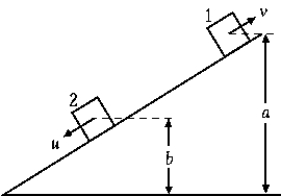Multiple Choice
 A block of mass m starts from position 1 and moves up a frictionless inclined plane with an initial speed v. At some later time the block has moved down the plane and at position 2 has a speed u. If a and b are the heights above the bottom of the plane, the magnitude of u can be determined from
A block of mass m starts from position 1 and moves up a frictionless inclined plane with an initial speed v. At some later time the block has moved down the plane and at position 2 has a speed u. If a and b are the heights above the bottom of the plane, the magnitude of u can be determined from
A) u2 = v2 - 2g(a - b)
B) u2 = v2 + 2g(a + b)
C) u2 = v2 + 2g(a - b)
D) u2 = v2 + 2g(b - a)
E) u2 = v2 + g(a - b)
Correct Answer:

Verified
Correct Answer:
Verified
Q1: The minimum amount of energy released in
Q19: A 4.0-kg block starts from rest and
Q24: The reference point for gravitational potential energy<br>A)must
Q34: <img src="https://d2lvgg3v3hfg70.cloudfront.net/TB6080/.jpg" alt=" Release mass m
Q36: When a hydrogen atom absorbs a
Q39: <img src="https://d2lvgg3v3hfg70.cloudfront.net/TB6080/.jpg" alt=" When the potential
Q40: <img src="https://d2lvgg3v3hfg70.cloudfront.net/TB6080/.jpg" alt=" The block shown
Q41: Use the figure to the right to
Q41: <img src="https://d2lvgg3v3hfg70.cloudfront.net/TB6080/.jpg" alt="
Q42: The potential energy function for a conservative